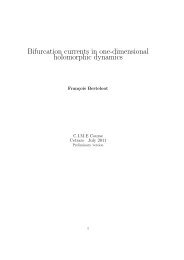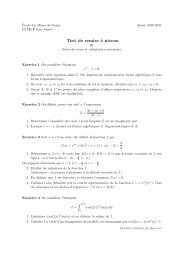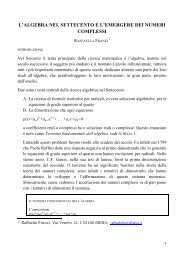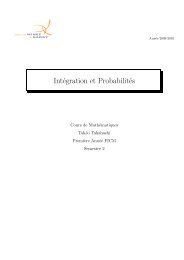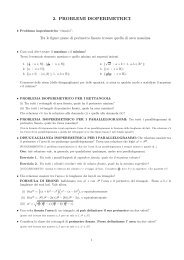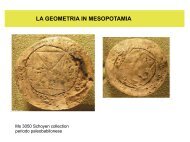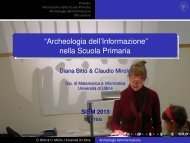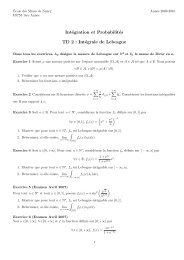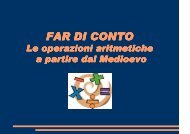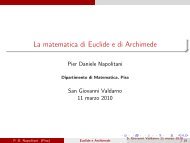Derivation of a fundamental diagram for urban traffic flow
Derivation of a fundamental diagram for urban traffic flow
Derivation of a fundamental diagram for urban traffic flow
Create successful ePaper yourself
Turn your PDF publications into a flip-book with our unique Google optimized e-Paper software.
12 The European Physical Journal B<br />
defined as<br />
∫x 1<br />
dx ′ w(x ′ )f(x ′ )<br />
x 0<br />
∫x 1<br />
. (A.1)<br />
dx ′ w(x ′ )<br />
x 0<br />
In case <strong>of</strong> uni<strong>for</strong>m arrivals <strong>of</strong> vehicles, we have a functional<br />
relationship <strong>of</strong> the <strong>for</strong>m f(x) =a + bx <strong>for</strong> the travel time,<br />
and the weigth function is constant, i.e. w(x) =w. Here,<br />
a = Ti 0,<br />
x = ΔN i,andb =1/A i =1/(u i ̂Q i ). With x 0 =0<br />
and x 1 = ΔNi<br />
max , the <strong>for</strong>mula <strong>for</strong> the average travel time<br />
becomes<br />
w[(ax 1 + bx 2 1 /2) − (ax 0 + bx 2 0 /2)]<br />
= a + b x 1 + x 0<br />
,<br />
w(x 1 − x 0 )<br />
2<br />
(A.2)<br />
wherewehaveused(x 2 1 − x 2 0 )=(x 1 − x 0 )(x 1 + x 0 ).<br />
Inserting the above parameters, we obtain the previously<br />
derived result<br />
T i = T 0<br />
i<br />
+<br />
ΔN<br />
max<br />
i<br />
2u i ̂Qi<br />
. (A.3)<br />
When determining the average velocity Vi<br />
av , the function<br />
to average over is <strong>of</strong> the <strong>for</strong>m f(x) =c/(a + bx), where<br />
c = L i and the other parameters are as defined be<strong>for</strong>e. We<br />
use the relationship<br />
∫ x 1<br />
dx ′ wc<br />
a + bx ′ = wc (<br />
)<br />
ln |a + bx 1 |−ln |a + bx 0 |<br />
b<br />
x 0<br />
= wc ∣ ∣ ∣∣∣<br />
b ln a + bx 1 ∣∣∣<br />
.<br />
(A.4)<br />
a + bx 0<br />
Dividing this again by the normalization factor w(x 1 −x 0 )<br />
and inserting the above parameters finally gives<br />
V av<br />
i<br />
= L iu i ̂Qi<br />
ΔN max<br />
i<br />
(<br />
max<br />
i<br />
ln<br />
1+ΔN ∣ u i ̂Qi Ti<br />
0 ∣ ≈ L i<br />
Ti<br />
0 1 −<br />
ΔN<br />
max<br />
i<br />
2u i ̂Qi T 0<br />
i<br />
)<br />
,<br />
(A.5)<br />
wherewehaveusedln(1+x) ≤ x − x 2 /2. This <strong>for</strong>mula<br />
corrects the naive <strong>for</strong>mula<br />
V av<br />
i<br />
≈ L i<br />
T i<br />
=<br />
T 0<br />
i<br />
+<br />
L i<br />
ΔN max<br />
1<br />
2u i ̂Qi<br />
≈ L i<br />
T 0<br />
i<br />
(<br />
1 −<br />
)<br />
max<br />
ΔN1<br />
, (A.6)<br />
2u i ̂Qi Ti<br />
0<br />
wherewehaveused1/(1 + x) ≈ 1 − x. There<strong>for</strong>e, the<br />
above Taylor approximations <strong>of</strong> both <strong>for</strong>mulas agree, but<br />
higher-order approximations would differ. The <strong>for</strong>mulas<br />
in the main part <strong>of</strong> the paper result <strong>for</strong> Ni<br />
av = Ni max /2,<br />
which corresponds to the case δ i = 0 (i.e. f i − u i ).<br />
Generalizing the above approach to the case δ i > 0,<br />
we must split up the integrals into one over wc/(a + bx ′ )<br />
extending from x 0 =0tox 1 = ΔNi<br />
max and another one<br />
over wc/a from x 1 = ΔNi max to x 2 =(1− u i )A i T cyc =<br />
(1−u i )u i ̂Qi T cyc , where the specifications <strong>of</strong> a, b, andc are<br />
unchanged. Taking into account Vi 0 = L i /Ti 0,thisgives<br />
V av<br />
i<br />
= wL iu i ̂Qi ln |1+ΔN max<br />
i /(u i ̂Qi T 0<br />
i )| + Z<br />
w(1 − u i )u i ̂Qi T cyc , (A.7)<br />
where<br />
Z = wV 0<br />
i [(1 − u i )u i ̂Qi T cyc − ΔN max<br />
i ]. (A.8)<br />
Considering equation (15), we get<br />
V av<br />
i =<br />
L i<br />
(1 − u i )T cyc<br />
ln<br />
(<br />
1+(1− f i ) T cyc<br />
T 0<br />
i<br />
)<br />
+ Vi<br />
0 f i − u i<br />
.<br />
1 − u i<br />
(A.9)<br />
In second-order Taylor approximation, this results in<br />
[ ( 1 −<br />
Vi av ≈ Vi<br />
0 fi<br />
1 − (1 − f )<br />
i)T cyc<br />
1 − u i 2Ti<br />
0 + f ]<br />
i − u i<br />
,<br />
1 − u i<br />
(A.10)<br />
which can also be derived from equation (A.6), considering<br />
equation (15) and the percentage <strong>of</strong> delayed vehicles,<br />
which is given by equation (19).Thesameresultfollows<br />
from<br />
V av<br />
i =<br />
T 0<br />
i<br />
L i<br />
+ T av<br />
i<br />
≈ V 0<br />
i<br />
together with equation (21).<br />
References<br />
(1 − T i<br />
av )<br />
Ti<br />
0<br />
(A.11)<br />
1. D.C. Gazis, Traffic Theory (Kluwer Academic, Boston,<br />
2002)<br />
2. J. Esser, M. Schreckenberg, Int. J. Mod. Phys. B 8, 1025<br />
(1997)<br />
3. P.M. Simon, K. Nagel, Phys. Rev. E 58, 1286 (1998)<br />
4. K. Nagel, Multi-Agent Transportation Simulations, see<br />
http://www2.tu-berlin.de/fb10/ISS/FG4/archive/<br />
sim-archive/publications/book/<br />
5. M. Hilliges, W. Weidlich, Transpn. Res. B 29, 407 (1995)<br />
6. D. Helbing, J. Siegmeier, S. Lämmer, Networks and<br />
Heterogeneous Media 2, (2007)<br />
7. M. Cremer, J. Ludwig, Math. Comput. Simul. 28, 297ff<br />
(1986)<br />
8. C.F. Daganzo, Transpn. Res. B 29, 79 (1995)<br />
9. T. Nagatani, Phys. Rev. E 48, 3290 (1993)<br />
10. D. Chowdhury, A. Schadschneider, Phys. Rev. E 59,<br />
R1311 (1999)<br />
11. O. Biham, A.A. Middleton, D. Levine, Phys. Rev. A 46,<br />
R6124 (1992)<br />
12. J.-F. Zheng, Z.-Y. Gao, X.-M. Zhao, Phys. Stat. Mech.<br />
Appl. 385, 700 (2007)<br />
13. N.A. Irwin, M. Dodd, H.G. Von Cube, Highway Research<br />
Board Bulletin 347, 258 (1961)<br />
14. R.J. Smock, Highway Research Board Bulletin 347, 60<br />
(1962)<br />
15. W.W. Mosher, Highway Research Record 6, 41 (1963)<br />
16. Bureau <strong>of</strong> Public Roads, Traffic Assignment Manual<br />
(US Dept. <strong>of</strong> Commerce, Urban Planning Division,<br />
Washington, D.C., 1964)<br />
17. T.J. Soltmann, Highway Research Record 114, 122 (1965)<br />
18. K.B. Davidson, in Proceedings <strong>of</strong> the 3rd ARRB<br />
Conference, Part 1 (Australian Road Research Board,<br />
Melbourne, 1966), pp. 183–194



